tuber
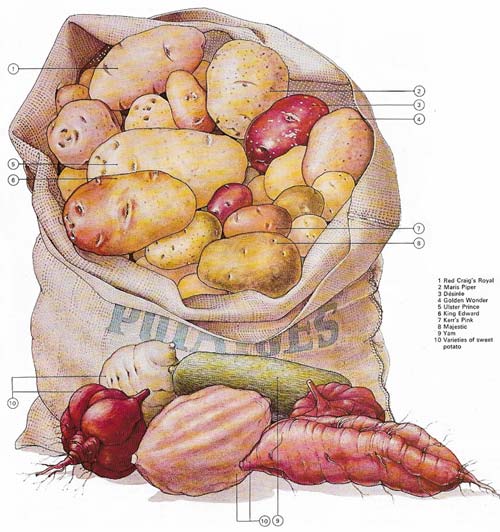
Figure 1. Most tubers are eaten fresh as vegetables. In temperate zones the main species is the potato, each variety of which is distinguishable by the color of its skin or flesh, or by the shape or texture of the tubers. Potatoes, if harvested in good condition, will store and travel well, losing none of their nutritional value. Much of the crop is shipped from Europe to South America to supplement supplies. The same kind of routine applies to other tubers such as yams and sweet potatoes. As immigrant populations increase in European centers these tubers are increasingly imported from the tropics, where they are grown, to meet immigrants' demands for traditional foods. 1 Red Craig's Royal 2 Maris Piper 3 Desiree 4 Golden Wonder 5 Ulster Prince 6 King Edward 7 Kerr's Pink 8 Majestic 9 Yam 10 Varieties of sweet potato
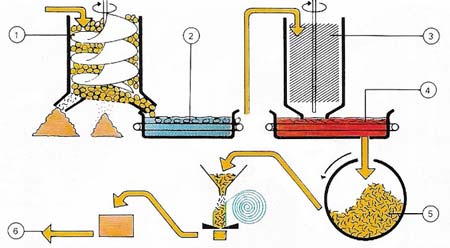
Figure 2. Potatoes are manufactured into chips (crisps), one of the chief forms of processed potato. The tuber must be high in dry matter and low in sugar content to be suitable for crisping. The potato is peeled (1) and washed (2) mechanically, sliced (3) and blanched in boiling water before frying (4). The chips are then dried and to some batches flavoring is added (5) before packaging (6) ready for distribution. All this is done automatically.
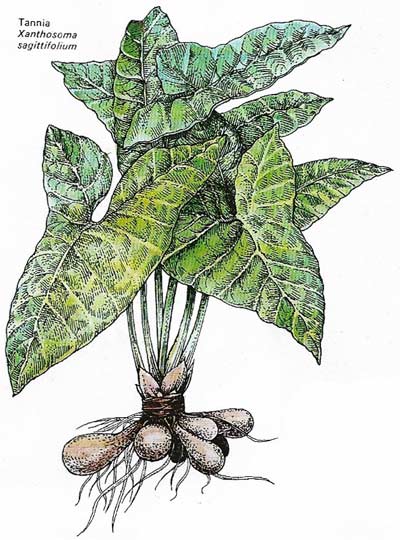
Figure 3. The rhizomes of the tropical tannia plant are collected and ground into meal. The plant grows to 3 m (10 ft) in height.
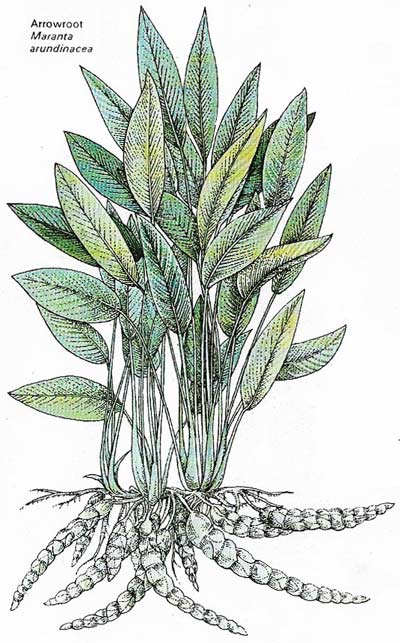
Figure 4. Arrowroot mostly grows on the West Indian of St Vincent. It has rhizomes that produce a starchy powder used for thickening sauces.
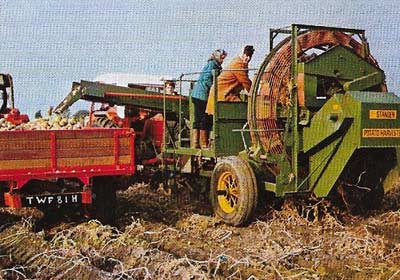
Figure 5. Potatoes can be harvested mechanically or by hand. Hand picking of early crops continues when mechanical lifting is stopped by bad weather, so allowing the crop to reach the market when the price for early new potatoes is high.
Tubers are underground stems specially modified for the storage of plant foods. Root tubers have the same function but are modified roots. Rhizomes are another type of storage organ but are modified stems that grow underground. Tubers form part of the staple diet of almost all modern societies from urbanized Europe and North America to the tropics of Africa and Asia.
The most important tuber
To Western peoples, the most important tuber is the potato (Solanum tuberosum). It was taken to Europe by the Spaniards in the sixteenth century from South America, where it had been a vital part of the Peruvian diet from about AD 200.
Europe accepted the potato gradually and it was not until the late 1580s that it appeared in the British Isles. Crop development was fastest in peasant economies – notably in Ireland – but after the mid-nineteenth century the potato's importance as a food source was recognized and the vegetable was cultivated more widely. Ironically, it was the major failure of the potato crop in Ireland in 1845–1846 and the devastating famine that ensued that alerted society to the potato's food value.
The potato grows best in well-drained, fertile soils and, because of this, its cultivation spread rapidly to the better crop-growing areas of Europe such as the east coasts of England and Scotland, the northern plains of France, and the fertile polder areas of The Netherlands. Similarly, its development in the United States has been greatest in the north – Idaho, Washington, and Maine.
Modern agricultural techniques, the use of chemical fertilizers, and the development of mechanized planting and harvesting have led to increased yields. Farmers on the best soils now harvest up to 40 tons of potatoes a hectare (16 tons an acre).
The potato crop
The potato crop is planted when the last spring frosts are gone. Tubers are placed about 1 meter (39 inches) apart in ridges, well covered with soil. The plant shoots emerge within two or three weeks of planting and the tubers of early varieties are harvested – usually by hand (Figure 5) – about three months after planting. The main part of the crop is lifted in autumn and a high percentage is stored to ensure year-round supplies.
 |
| The growth of the potato takes three to seven months depending on variety. The tuber is covered with earth in fertile ground and shoots its stems through "eyes" in the skin surface (A). At six weeks a large canopy of leaf growth develops and tubers grow (B) on underground shoots. Leaf growth is dried chemically (C) to aid lifting. |
The principal use of the potato (Figure 1) has traditionally been as a fresh vegetable, but now it is increasingly used as the raw material for the production of processed products. Frozen "french fries", chips (crisps) (Figure 2), dehydrated potato for human or animal feed, and a series of canned potato products are extending its use as a food. Worldwide, the trend towards processed and "convenience" foods has been marked and a large percentage of the global US potato crop is now eaten in this form. In Europe, notably in The Netherlands and Germany, processing into starch and alcohol has become an important industry.
The development of new uses for the potato and the need to adapt the plant to grow in many climates and to mature earlier or later for specific markets, has led to the development of major plant-breeding programs. Some varieties now available have the characteristics of early maturity, or high starch content or a smaller proportion of water than usual in the live weight.
Early maturing varieties of potato have become vital to the economy of many less-developed countries, especially around the Mediterranean. The varieties are ready for harvest in early spring and are exported to cities in northern Europe.
Less-productive tubers
Other tubers – mostly those in tropical areas – have not yet had the benefit of sophisticated plant-breeding programs and are therefore comparatively less productive. This situation is likely to change, particularly with cassava, a tall herb that originated in South and Central America. There are two useful species – Manihot dulcis, the sweet cassava, and Manihot utilissima (or M. esculenta), the manioc or tapioca plant.
 |
| The cassava has become one of the world's most important tubers because a processed form of meal, produced from its root, is used as a cereal substitute |
The sweet cassava is a root tuber eaten fresh as a vegetable or used as a source of starch. By far the most important species is the bitter cassava. When harvested the tuber is bitter and poisonous, but when the poisonous juice is washed away the tuber is processed into tapioca for human consumption and into cassava meal (also called manive) for animal feed. The meal's importance as a cereal replacement in animal feeding was highlighted during the world cereal shortage of 1973 and 1974. This shortage, and the need to make tropical countries more self-sufficient in food, is leading to far-reaching plant-breeding programs for cassava which will increase its importance.
Yam (Dioscorea sp) and two (Colocasia esculenta) are tubers that are of importance in their respective geographic areas. Yams are indigenous to tropical areas of both the Southern and Northern Hemispheres and taro, which originated in southeastern Asia, has become an important staple food in the Pacific Islands, particularly Polynesia where it forms the basis of a thick paste called poi.
The sweet potato (Ipomoea batatas) bears no relation to its more common namesake. It produces heavy crops of large, irregular tubers and is now widely cultivated as a vegetable in the southern US, Central America, the warm Pacific Islands, Japan, and Russia.


